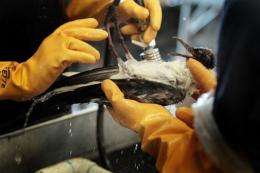Tar balls hit Texas as oil spill cost soars

Tar balls from the Gulf of Mexico spill have turned up on the Texas coast, expanding the oil slick's impact to all five Gulf states, officials said late Monday, as BP's disaster costs soared above three billion dollars.
Meanwhile a giant Taiwanese ship deployed to boost the clean-up remained in testing, with initial results inconclusive because of choppy waters, but bad weather on the horizon threatened to further disrupt clean-up efforts.
The A Whale tanker cruised near the Deepwater Horizon oil spill, but Bob Grantham, a spokesman for the super-skimmer's owner, TMT Shipping, said results were "inconclusive in light of the rough sea state we are encountering."
Grantham said the company, working with the US Coast Guard, would continue testing the ship "to make operational and technological adjustments" for the supertanker.
The ship is believed to be able to suck up to 500,000 barrels (21 million gallons) of oily water a day through its "jaws," a series of vents on the side of the ship.
By comparison, more than 500 smaller vessels in 10 weeks have only managed to collect some 31.3 million gallons of oil-water mix between them.
The tar balls found in the surf in Galveston, Texas, were tested and determined to be from the BP oil spill. But officials stressed that it was not clear if they drifted hundreds of miles from the site of the well that ruptured April 20, triggering the disaster, or if they fell or leaked from a ship carrying collected oil to Texas for processing.
"The testing found that the oil was lightly weathered, raising doubts that the oil traversed the Gulf from the spill source," officials of a joint BP-US government response team said in a statement.
More than 492 miles (792 kilometers) of US shoreline across the five Gulf states -- Louisiana, Mississippi, Alabama, Florida and now Texas -- have now been oiled by the disaster.
Meanwhile, oil sheen and tar balls were spotted Monday near the mouth of Lake Pontchartrain in Louisiana, prompting response crews to unfurl 600 feet (200 meters) of boom to prevent more oil from sullying the estuary.
Cleanup operations were scheduled to resume Tuesday, officials said.
BP said its latest estimate showed the costs to the British energy firm had risen in the past week.
"The cost of the response to date amounts to approximately 3.12 billion dollars, including the cost of the spill response, containment, relief well drilling, grants to the Gulf states, claims paid, and federal costs," BP said.
BP's share price has collapsed more than 50 percent since the Deepwater Horizon oil rig it leased sank on April 22, two days after a blast that killed 11 workers.
After intense pressure from President Barack Obama over the worst ever US environmental disaster, BP agreed last month to suspend its shareholder dividend and create a 20-billion-dollar fund for costs arising from the spill.
BP is also selling non-core assets to raise 10 billion dollars, while international ratings agencies have downgraded the company's credit worthiness.
Nearly a week after Hurricane Alex swept through the region, bad weather continued to hamper the clean-up, keeping smaller skimming vessels tied up in harbors in Mississippi, Alabama and Florida.
Skimming and other operations have resumed in calmer seas off Louisiana.
But the National Hurricane Center warned early Tuesday that a new low-pressure system over the Yucatan peninsula and the Caribbean Sea and heading into the Gulf of Mexico had a 30-percent chance of developing into a tropical cyclone in the next 48 hours.
Although there was no direct hit from Alex, this year's first major Atlantic storm provided a reminder of the urgent need to clean up an oil disaster surpassed only by Iraqi troops' deliberate release of crude in Kuwait during the 1991 Gulf War.
The US Navy's MZ-3A Airship was expected to reach the Gulf Coast Tuesday to help detect oil, direct skimming vessels and search for wildlife threatened by the thick brown-orange mess.
The fractured pipe that connected the BP-leased platform to the well a mile (1,600 meters) down on the seafloor has now spewed somewhere between two and four million barrels of oil into the Gulf.
The firm's current containment systems can only capture or flare some 25,000 barrels of oil a day, a number set to double when a third vessel is expected to be in place on Thursday.
It will likely be mid-August at the earliest before the ruptured well is permanently capped by injecting mud and cement with the aid of relief wells.
(c) 2010 AFP




















